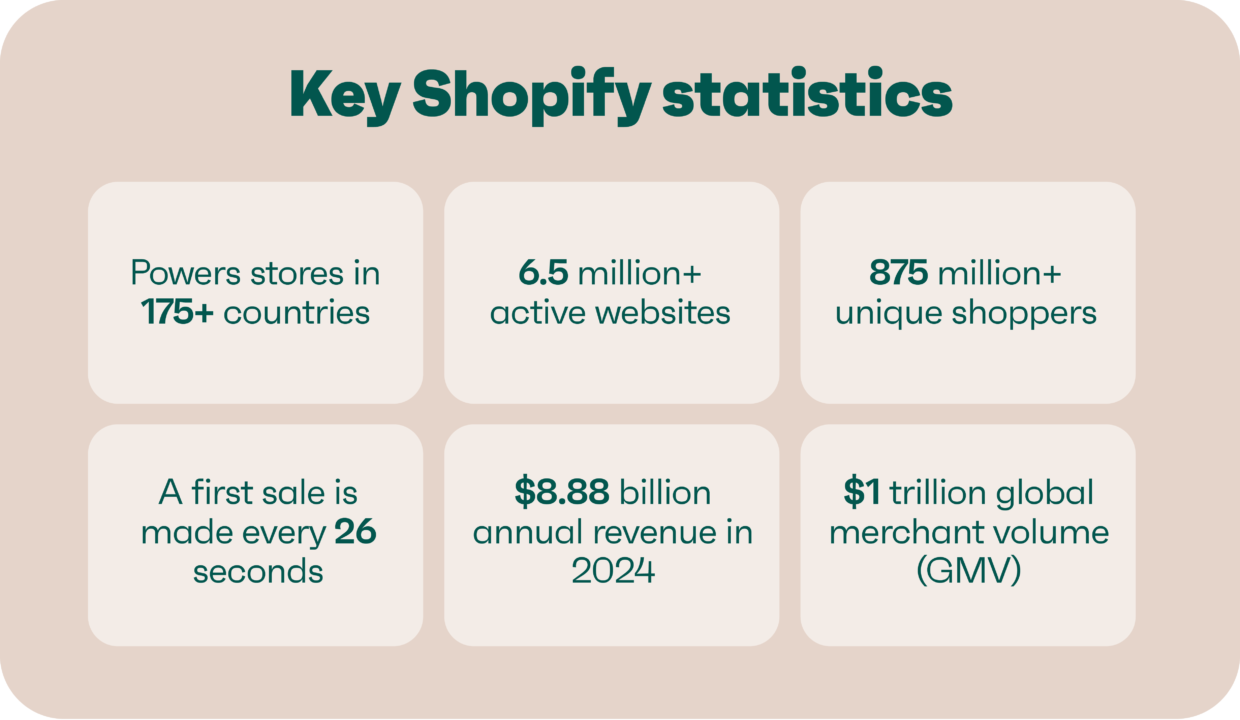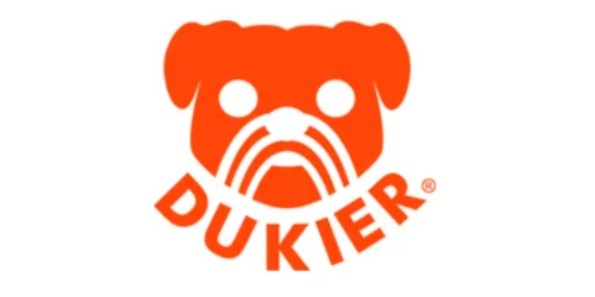Drive sales on autopilot with ecommerce-focused features
See FeaturesShopify captured 30% of US ecommerce businesses in 2025, with over 875 million shoppers purchasing from its stores in 2024.
The platform achieved a remarkable $1 trillion in cumulative gross merchandise volume, reflecting a consistent growth trend with a 26% revenue increase in 2024.
Shopify's international revenue surged by 33% in Q3 2025, indicating its strong potential for future global market expansion despite currently trailing behind competitors like WooCommerce.
Entrepreneurs on Shopify make their first sale every 26 seconds, showcasing the platform's efficiency in facilitating new business success.
Shopify statistics show that it is one of the most popular ecommerce platforms globally by market share, with its merchants generating more than $1.4 trillion in revenue as of 2025.[1]
A few headline numbers include 30% of US ecommerce businesses selling through Shopify, and 875 million shoppers buying from Shopify stores in 2024. Its full-year revenue grew 26% with a staggering $1 trillion[2] in cumulative gross merchandise volume (GMV).
Global ecommerce sales forecasts predict 6.8% growth to $6.419 trillion in 2025[3], so don’t be surprised when Shopify beats its own numbers in 2026.
It won’t all be down to marketing, either. Shopify is stable, cost-effective, and above all else, proven, with big-hitters such as Estée Lauder, Gymshark, Mattel, and Supreme all running it.
We’ve only just scratched the surface of Shopify’s market position, sales, and where it’s heading, with plenty more to discover below.
Quick sign up | No credit card required
Key Shopify statistics 2026 snapshot
Shopify hit its stride in 2025 with more growth than in 2024 and new big-brand customers onboarding, such as Estée Lauder. It has even forecast momentum[4] that’s going to pick up as it heads into Q4 2025 and Q1 2026.
The key stats:
- Market position in the US: 30% of US ecommerce businesses sell through Shopify.
[5] - How many people use Shopify: 875 million+ shoppers bought from Shopify merchants in 2024.
[6] - Time to first sale: An entrepreneur makes their first sale every 26 seconds.
[7] - Global penetration: Millions of businesses in 175+ countries.
[8] - Number of live (active) stores: 6,519,105 active stores (November 2025).
[9] - GMV: Over $1 trillion in cumulative order value processed in 2024.
[10] - Revenue growth in 2024: $8.88B, up 26%, racking up its seventh straight quarter over 25% growth.
[11] - Revenue growth in 2025: 32% revenue and GMV growth in Q3, up from 26% and 24% in 2024.
[12]

That’s our Shopify statistics snapshot. Next up, let’s look at Shopify’s global performance in more detail and figure out where it stands in comparison to other platforms.
New to Shopify? Read these guides:
Shopify best practices: A comprehensive guide (2025)
Shopify review 2025: Is it still the best ecommerce platform?
Shopify’s global ecommerce impact
Let’s look at Built With, which tracks global usage statistics and gives us an answer to how many people use Shopify. We can see that the number of stores using Shopify has increased by more than two million[13] from January 2025 to November 2025 (circa 4.5 million to 6.5 million).
Its live country totals also increased across all key markets. The top five:
| Rank | Country | Store count (November 2025) |
|---|---|---|
| One | United States | 3,549,339 |
| Two | United Kingdom | 240,926 |
| Three | Germany | 182,285 |
| Four | Australia | 170,002 |
| Five | Canada | 134,646 |
Those numbers show us that Shopify has more than 14x the number of stores in the US as it does in its second biggest market, the UK, and that impressive volume translates to it being the most popular ecommerce platform in the US.[14]
Shopify’s market share in the UK[15] is greater than ever as of September 2025, sitting at over 20%, behind only Wix. WooCommerce comes third for Brits.
Looking at Shopify Plus, Shopify’s enterprise product, Built With[16] shows it powers 76,607 stores as of November 2025, including 41,137 in the US, and 5,534 in the UK.
On a global scale, Statista data shows that Shopify lags behind WooCommerce,[17] Squarespace Online Stores, and WooThemes as of 2024. The stats:
- WooCommerce powers 39.05% of stores
- Squarespace Online Stores powers 14.75%
- Woo Themes powers 13.96%
- Shopify’s 10.56% share is over 3x less than WooCommerce’s
So, Shopify definitely has work to do if it wants to dominate the global ecommerce scene, but it’s already making excellent strides with its latest figures. These show 24% GMV growth and 33% international revenue growth[18] in 2024.
A recent success example is Black Friday 2024, during which its merchants generated $11.5 billion in global sales,[19] a 24% increase in sales from 2023.
It isn’t just smaller retailers using Shopify, either, with JB Hi-Fi, Meta, Estée Lauder, Gymshark, ButcherBox, SKIMS, Supreme, and many more leading brands using it.
The core factor behind that relentless Shopify market share growth is its stable, cost-effective ecosystem, but also its investment in commerce features that its merchants want.
For instance, a 2025 Smartly study found that 73% of marketers[20] plan to increase their conversational commerce investments by up to 50% by 2027. Then, in September 2025, Shopify announced that it’s bringing commerce to ChatGPT.[21]
Shopify merchant performance and average earnings
Now that you know all about Shopify’s growth (impressive, isn’t it?), the questions on your lips will probably be around how much does the average Shopify store make per month, and how much money you can make on Shopify.
The answer? Some serious money, but there’s plenty of revenue, profit, and earnings insights to unpack, which we’ll cover now:
- Gross Merchandise Volume (GMV) trends: The trend is upwards. Merchants hit the $1 trillion milestone in cumulative GMV
[22]in 2024, with 2.4x more GMV than in 2020, set against annual growth rates of 26% in 2024, 26% in 2023, and 21% in 2020. - Black Friday/Cyber Monday stats: Merchants served 76+ million customers
[23]and generated $11.5 billion in sales during BFCM in 2024, an increase of 24% from 2023. At its peak, customers were spending $4.6 million per minute. - Average Shopify store revenue: Average revenues are niche and model dependent, but True Profit reckons that most Shopify stores make under $1,000/month,
[24]with at least 20% reaching the $10,000/month milestone. - Profitability and success rate: Shopify says that its merchants make their very first sale every 26 seconds,
[25]and that overall, they have generated more than $1.4 trillion in revenue. According to most Reddit users,[26]they average 15-30% net profit. - Dropshipping and high-end earnings: The global dropshipping market
[27]could reach $435 billion by the end of 2025, and with Shopify Collective,[28]Shopify makes finding high-quality suppliers easy. Earnings range from a few hundred dollars/month to over $100k/month. - Average Order Value (AOV): Research platform Dynamic Yield
[29]puts the AOV from consumer goods at $296 as of October 2025. However, AOVs are niche dependent, with the luxury and jewelry niche having the highest AOV of $328. - Repeat Purchase Rate: According to Smile.io,
[30]a customer has a 27% chance of returning to your store[31]after one purchase. With an email marketing app, such as Omnisend, it’s possible to follow-up, cross-sell, and maximize repeat purchases on Shopify. - Product Return Rate: The National Retail Federation’s 2024 report on consumer trends found that 16.9% of customers
[32]returned products. Shopify says this can be as high as 30%,[33]although it depends entirely on your products and service quality.
 | Customer success story Shopify merchant and Omnisend customer Dukier grew its revenue by 525% in three years, reaching €518,860 by 2025, thanks to localized email automations across five languages, which accounted for 55% of revenue. Read the case study. |
Quick sign up | No credit card required
Shopify corporate and financial statistics
Check out these Shopify statistics to understand how, and in what context, it is succeeding in making its ecommerce tool the most popular choice:
- Shopify company financials: $8.88 billion in revenue in 2024
[34]equates to a 25.78% increase from 2023, which went up 26.06% from 2022. 2025’s Q2 revenue[35]grew 32%, and in Q3,[36]it rose 32% again, marking nine consecutive quarters of growth. - Shopify stock and market cap: In the year-to-date (20 November 2025), Shopify stock has increased in value by 41.95% to $152.73. Its market cap is $188.19 billion.
- Shopify profitability: $1.1 billion in operating income in 2024, with $1.6 billion in free cash flow generated the same year.
- Shopify employee statistics: Shopify had 8,100 employees
[37]at the end of 2024. 48% of employees recommend working there, according to 4,000+ reviews on Glassdoor.[38] - Investment and acquisition stats: Search startup Vantage Discovery
[39]was Shopify’s most prominent acquisition in 2025 for $59 million. Additional acquisitions from 2024-25 include Threads[40]and Checkout Blocks.[41]In 2025, Shopify announced an investment in conversational commerce[42]with ChatGPT, plus Magic and Sidekick[43]with AI features. - Social good initiatives: Frontier
[44]is one of Shopify’s most prominent initiatives, committing $1 billion in permanent carbon removal by 2023. Its Sustainability Fund also works with 50 companies that need solutions for carbon reduction.
Shopify usage and merchant trends
According to Built With,[45] there are more fashion brands on Shopify than any other niche. The table below shows the top five store categories by merchant count:
| Rank | Category | Store count (November 2025) |
|---|---|---|
| One | Fashion | 101,763 |
| Two | Apparel | 83,421 |
| Three | Jewelry | 69,529 |
| Four | Bags | 40,101 |
| Five | Coffee | 29,054 |
Another interesting thing we found is how those store categories change for Shopify’s enterprise-grade platform, Shopify Plus. The data shows there are more nutrition brands than bag brands,[46] and more apparel than fashion brands:
| Rank | Category | Store count |
|---|---|---|
| One | Apparel | 2,226 |
| Two | Fashion | 2,076 |
| Three | Nutrition | 1,512 |
| Four | Shoes | 1,510 |
| Five | Bags | 1,336 |
One of the drivers behind Shopify’s popularity among fashion and apparel brands is its dropshipping ecosystem, including Shopify Collective and third-party apps such as DSers, which make selling without inventory easy.
Entrepreneur Kamil Sattar made his fortune dropshipping on Shopify,[47] and he reveals his dropshipping secrets in the video below, if you’re interested in this aspect of ecommerce:
Now, you’re probably wondering how Shopify merchants are shipping their products. The answer is with one of Shopify’s shipping partners, who provide discounted shipping rates (with the total discount dependent on your plan). Carriers include:
| Market | Primary shipping carriers |
|---|---|
| UK | DPD UK, Evri, Yodel |
| USA | USPS, UPS, DHL Express |
| Canada | Canada Post, Purolator |
| Australia | Sendle |
| France | Colissimo, Chronopost, Mondial Relay |
| Italy | Poste Italiane, BRT |
| Spain | Correos, SEUR |
| Germany | DHL Paket |
According to Pitney Bowes,[48] the U.S. Postal Service (USPS), Amazon Logistics (not a Shopify partner), UPS, and FedEx handle approximately 97% of all domestic shipments, split as follows:
- USPS, 31%
- Amazon Logistics, 28%
- UPS, 21%
- FedEx, 17%
That data falls in line with Shopify saying that USPS is its most-used carrier[49] as of 2025, with Statista showing UPS and FedEx in second and third place.[50]
Here are some additional Shopify usage statistics:
- Average conversion rates: These sat at 1.4% by the end of 2023 according to Littledata,
[51]with anything above 3.2% putting you in the top 20%, and 4.7% making you a top 10 store - Product counts: Most Shopify stores have between 10 and 50 products (two million plus), while the pool of stores selling more than 50 but less than 500 products is 915,000, according to Built With
- Social media: Instagram is used by 46.6% of Shopify stores, Facebook by 28.7% of stores, and TikTok by 12.1% of stores as of November 2025.
[52] - Technologies: The top five third-party technologies used by merchants are Cloudflare, Cloudflare CDN, Arrive, Apple Pay, and Google Pay (Store Leads)
- Traffic sources: According to ZIK Analytics, 68% of Shopify traffic comes from mobile,
[53]and its mobile checkout accounts for 79% of purchases
Additional reading:
Shopify conversion rate optimization: 10 proven tactics
Shopify App Store and integration statistics
The Shopify App Store provides thousands of apps for store customization, with three in four merchants using apps[54] to help run their business and installing six apps on average.
More than 3,800 developers build on the Shopify App Store, with 16 million installs since 2020, generating over $230 million in revenue for developers.
Here are Shopify App Store statistics as of November 2025:
- Over 13,000 apps
- 1,091 Built for Shopify
[55]apps, passing Shopify’s highest development standards - 39 Apps by Shopify,
[56]developed by Shopify to provide native dashboard functionality
The most lucrative apps for developers are Built for Shopify ones, which achieve an average increase of 49% new installs[57] in just 14 days of status approval.
Top categories across all apps include dropshipping, marketplaces, product reviews, upsell and bundles, email marketing, SEO, shipping, and currency and translation.
According to Store Leads,[58] these are the most-installed Shopify apps:
| Rank | App | Stores | App type |
|---|---|---|---|
| One | Judge.me Product Reviews App | 513,470 | Reviews |
| Two | Klaviyo: Email Marketing & SMS | 383,014 | Marketing |
| Three | Shopify Inbox | 382,082 | Customer Service |
| Four | Product Reviews | 275,847 | Reviews |
| Five | Instafeed ‑ Instagram Feed | 238,804 | Social Media |
| Six | PageFly Landing Page Builder | 238,437 | Design |
| Seven | Klarna On‑Site Messaging | 224,367 | Payments |
| Eight | Shopify Forms | 160,338 | Lead Capture |
| Nine | Mailchimp Email SMS Marketing | 153,417 | Marketing |
| Ten | Printful: Print on Demand | 147,075 | Fulfillment |
Notice how there are two entries in the top 10 under marketing and reviews? That tells us these categories are the most popular overall.
However, the top results in our table aren’t necessarily the best apps in their categories, nor the most reviewed. For instance, Klaviyo’s rating is 4.7/5 based on 2,577 reviews, while Omnisend has a superior 4.8/5 rating[59] based on 2,863 reviews.
 | Vagari Bags switched from Klaviyo to Omnisend for better support and lower costs. It achieved 50% email open rates, 6-7% SMS click rates, and a £121 return for every £1 spent. Read the Omnisend customer story: Vagari Bags. |
Shopify Plus statistics (enterprise level)
Shopify Plus[60] costs $2,300/month for a three-year term. It’s for big and fast-growing stores, with the likes of Gymshark, Fashion Nova, Huel, and Alo Yoga using it.
Most Shopify Plus stores fly under the radar, though, with 76,607 of them live[61] as of November 2025, and more than 300 new stores launching each week.
14 stores sit within the top 1,000 for global traffic volume, and 729 stores have 1m+ social media followers. The number of US Shopify Plus stores is 41,137. Canada is the next-biggest market at 6,180, and then the UK at 5,534.
According to Shopify, merchants generating $1m to $500m are growing an average of 126% YoY on Shopify Plus, 690% above the industry average.
Here are some additional Shopify statistics:
- It offers up to 36% better total cost of ownership
[62](TCO) than competitors, including 36% better than WooCommerce and 35% better than Salesforce Commerce Cloud - The overall conversion rate for Shopify Plus is 36% better than the competition
- Its native features offer uplifts in results, such as 50% lower customer acquisition costs
[63]with Shopify Audiences and 20% higher average order values with Shopify Functions
Additional reading:
Upgrade to Shopify Plus: Complete guide for 2025
Shopify platform and ecosystem statistics
These stats detail more about how merchants use Shopify:
- Top Shopify themes: Dawn is the most popular theme with installs on 16.65% of stores,
[64]followed by Debut with 7.58% of installs - New feature releases: Shopify releases 150+ new features
[65]every six months, and spent $1.4 billion[66]on research and development in 2024 - Store switching and churn: 42.2% of new enterprise launches
[67](top 10,000 sites, $50M+ GMV) in the past two years chose Shopify, and over 1,200 enterprise brands are added annually to Shopify (net migration), with many switching from Adobe Commerce and Salesforce Commerce Cloud - Top-level domain distribution: 67.2% of stores
[68]have a .com domain, 3.1% have a .store domain, and 2.9% have a .shop domain - Merchant contact information: 59% of Shopify merchants have an email address, and 33% have a phone number on their websites
Conclusion: The state of Shopify in 2026
Is Shopify still relevant in 2026? Consider this:
- 30% of US ecommerce businesses sell through the Shopify platform
- Its revenue has grown over nine consecutive quarters to November 2025
- New entrepreneurs make their first sale every 26 seconds
- More than 875 million consumers bought something via Shopify stores in 2024
- Its Q4 2025 outlook forecasts revenue to grow at a mid-to-high-twenties percentage rate YoY
[69]
So, yes, Shopify is relevant, and its influence is growing.
The most impressive Shopify statistic is its handling of 30% of US ecommerce sales, and even though it’s behind WooCommerce, Squarespace Online Stores, and WooThemes for global market share, we have to put a firm “for now” label on that.
You see, Shopify’s international revenue grew 33% in Q3 2025 alone, and its sights are firmly set on capturing as many global customers as possible.
Its investment in features, proven merchant results, and high-quality app ecosystem will continue luring new customers over, with apps such as Omnisend improving on core features and helping merchants maximize sales.
Whichever way you strike it, Shopify’s trajectory is sharply upwards, with 2026 nailed on to bring about more customers, sales, and market share.
Quick sign up | No credit card required
FAQs
Five to 10% is the average for Shopify merchants, although it depends on the niche and ecommerce model (e.g., dropshipping and white label).
It’s more relevant than any other ecommerce platform in the US, capturing 30% of sales with growing influence across additional key markets, including Europe, the UK, and Asia.
Less than $1,000/month, though 20% of stores reach the $10k/month milestone. Some stores, such as Gymshark, do hundreds of millions in sales.
WooCommerce for standard Shopify plans, and on the enterprise side, Adobe Commerce and Salesforce Commerce Cloud.
Nope, and it’s nowhere near close. Shopify’s market cap is $188.19 billion. Amazon’s is $2.32 trillion, equating to a percentage gap of around 1,132% (Shopify is around 12x smaller than Amazon).
For a typical $100 online sale, Shopify charges between $2.80 and $3.20 in transaction fees, with Basic plan users paying 2.9% plus 30 cents.
No, neither on its primary site nor in its shop. The official Tesla Shop is often quoted as using Shopify Plus, but CMS checks show it uses Drupal (with a custom build).
You can check an app’s reviews on the Shopify App store to find stores using it, or inspect the source element of a website for any app mentions.
Sources:
- https://www.shopify.com/blog/what-is-shopify
- https://shopifyinvestors.com/media-center/news-details/2025/Shopify-Merchant-Success-Powers-Q4-Outperformance-Across-Both-Top-and-Bottom-Line/default.aspx
- https://www.emarketer.com/content/worldwide-retail-ecommerce-forecast-2025
- https://www.shopify.com/news/shopify-q3-2025-financial-results
- https://www.statista.com/statistics/950591/united-states-ecommerce-platforms-market-share/
- https://shopifyinvestors.com/resources/default.aspx
- https://trends.builtwith.com/shop/Shopify
- https://www.statista.com/statistics/685438/e-commerce-software-provider-market-share-in-the-uk/
- https://trends.builtwith.com/shop/Shopify-Plus
- https://www.statista.com/statistics/710207/worldwide-ecommerce-platforms-market-share/
- https://shopifyinvestors.com/media-center/news-details/2024/New-Achievement-Unlocked-Shopify-Merchants-Drive-Record-High-11.5-Billion-in-Sales-over-Black-Friday-Cyber-Monday/default.aspx
- https://www.businesswire.com/news/home/20250227514423/en/Smartly-Research-Reveals-Conversational-Commerce-as-Advertisings-Next-Frontier
- https://www.shopify.com/news/shopify-open-ai-commerce
- https://www.shopify.com/news/bfcm-data-2024
- https://trueprofit.io/blog/how-much-can-you-make-from-shopify
- https://www.reddit.com/r/shopify/
- https://www.oberlo.com/statistics/dropshipping-market
- https://www.shopify.com/collective
- https://marketing.dynamicyield.com/benchmarks/average-order-value/
- http://Smile.io
- https://blog.smile.io/repeat-customers-profitable/
- https://nrf.com/media-center/press-releases/nrf-and-happy-returns-report-2024-retail-returns-total-890-billion
- https://www.shopify.com/uk/enterprise/blog/ecommerce-returns
- https://www.shopify.com/news/shopify-q2-2025-financial-results
- https://www.shopify.com/news/about-us
- https://www.glassdoor.co.uk/Reviews/Shopify-Reviews-E675933.htm
- https://www.marketscreener.com/quote/stock/SHOPIFY-INC-22283351/news/Shopify-Inc-acquired-Vantage-Discovery-Inc-for-59-million-49343906/
- https://techcrunch.com/2024/06/07/shopify-acquires-threads-no-not-that-one/
- https://techcrunch.com/2024/06/03/shopify-checkout-blocks-acquisition/
- https://www.shopify.com/magic
- https://www.shopify.com/climate
- https://www.pitneybowes.com/us/shipping-index.html
- https://www.shopify.com/blog/best-shipping-options-small-business
- https://www.statista.com/statistics/1402024/leading-shipping-carriers-shopify-online-stores/
- https://www.littledata.io/ecommerce-conversion-rate
- https://storeleads.app/reports/shopify#socialmedia
- https://www.zikanalytics.com/blog/shopify-statistics/
- https://www.shopify.com/about/app-store-principles
- https://apps.shopify.com/app-groups/highlights/built-for-shopify
- https://apps.shopify.com/partners/shopify
- https://www.shopify.com/partners/blog/built-for-shopify-updates
- https://storeleads.app/reports/shopify/most-installed-apps
- https://apps.shopify.com/omnisend
- https://www.shopify.com/plus
- https://www.shopify.com/enterprise/blog/ecommerce-total-cost-of-ownership
- https://www.shopify.com/landing/plus-ppc
- https://meetanshi.com/blog/shopify-themes-statistics/
- https://www.shopify.com/resources/gartner-magic-quadrant
- https://www.shopify.com/enterprise
- https://www.shopify.com/enterprise/blog/enterprise-exodus
- https://storeleads.app/reports/shopify
TABLE OF CONTENTS
TABLE OF CONTENTS


No fluff, no spam, no corporate filler. Just a friendly letter, twice a month.

 OFFER
OFFER







